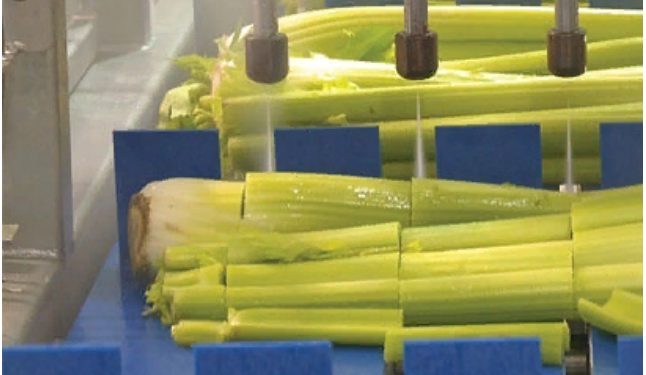The use of high-pressure jets of water as a way to cut produce may be beginning to emerge as an alternative for fresh-cut processors.
The technology for waterjet cutting has been around for decades, first appearing in the 1970s and taking off in the 1980s with the advent of abrasive cutting of metals, stone and glass.
The use of waterjet cutting by food companies has always been “somewhat marginal,” said Skip Reynolds, manager of food and emerging markets for KMT Waterjet.
“Waterjet cutting in produce is where waterjet cutting of stainless steel was 25 years ago,” Reynolds said. “People had never heard of it, or if they had heard of it, they didn’t know how it worked or why anybody would use it. The produce industry is now on the learning curve.”
Research is helping increase the knowledge base about waterjet cutting, including a recent project conducted by the University of California Davis, presented at this year’s United Fresh convention in Chicago. The project investigated how the water jets compared with conventional methods (stainless steel knives) in cutting romaine lettuce. The study observed cut surface defects on the romaine, including whitening dehydration and red discoloration.
The major mechanical factors determining the quality of a waterjet cut include the type of nozzle, conveyor speed and water pressure. The UC Davis researchers analyzed these factors in two research tests comparing a conventional cutting machine using new or used and reconditioned blades with a KMT pilot waterjet system.
In one of the tests, two different kinds of waterjet nozzles were compared: standard (fuzzy) nozzles and food-grade (sharp) nozzles.
“The sharp nozzle is a special nozzle with characteristics to give improved cutting on produce. The fuzzy nozzle is your standard off-the-shelf nozzle that everybody has. The study validates the fact that, for the food industry, the sharp nozzle is a better nozzle,” Reynolds said.
In this test, romaine lettuce of very high quality was cut with four treatments — dull knives, sharp knives, fuzzy nozzles and sharp nozzles. One set of cuts was placed in modified atmosphere packaging (MAP) and stored at 40° F (4.4° C). A second set was packaged in air and stored at 36.5° F (2.5° C).
No noticeable differences were observed among the cutting treatments until after 12 days storage in air. After 18 days, the sharp nozzle proved to be the best cutting treatment, with the romaine displaying less red discoloration than the new blade cuts. New knife blades produced less damage than used and reconditioned blades.
In the second test, the romaine was cut with used and new knives and by the sharp nozzles. The lettuce showed quality changes faster than in the first test, with discoloration appearing by day eight. By 12 days in air at 36.5° F, there were significant differences among the treatments, with romaine cut with the waterjet showing superior quality.
In both tests, only minor differences were observed in cut surface defects in product placed in MAP until day 15. Large differences in cut damage were seen in romaine stored in non-modified atmosphere plastic bags at 36.5° F.
“Overall, the food-grade nozzle waterjet lettuce surface showed higher quality than the blade-cut surfaces,” according to the research report summary. “Potentially, improved cutting technology could reduce the need for extreme packaging atmospheres and/or ensure higher product quality with package leakers.”
Using waterjet cutting for food is “in the very early stages of development for us,” said KMT’s Reynolds. The company sends the bulk of its equipment to various industries, especially to automotive plants, for cutting metal, composites and carpeting.
In produce, waterjet cutting has found the highest level of acceptance in celery, Reynolds said. Interest level in romaine cutting is high, with the UC Davis study lending assistance to the development stage.
“The question isn’t whether a waterjet can cut romaine, but what type of machine needs to be developed to utilize water to cut it,” he said.
Waterjet cutters are being used in South America and Central America for tipping green beans, and there is additional interest in using the technology for cutting asparagus, chunking melons, capping strawberries and trimming green onions. The technology is not yet suitable for cutting other types of produce, such as apples due to the browning of cut fruit, and citrus because of the pulp.
The KMT technology has been on display at recent food industry trade shows. Reynolds said the reactions he gets to the use of waterjet cutting are usually, “I’ve never heard of it,” or “I’ve heard of it, but I’ve never seen it.”
“But we feel food is a viable market for us,” Reynolds said. “That’s why we spend all the time and effort on it.”







